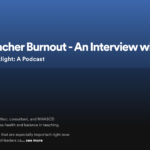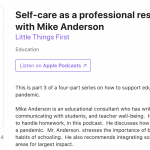Ask the Authors: Mike Anderson and Margaret Berry Wilson
Whom did you have in mind as you wrote these books?
Margaret: I had two groups in mind: brand-new teachers, and also teachers getting ready to teach a new grade level. I thought back to when I started teaching, and the way it seemed as if there was all this “secret stuff” other teachers seemed to know. I wanted to reveal some of that wisdom so beginning teachers could use it right away. I also thought about what I wished I’d known when I switched from first grade to second, and then from second to kindergarten, and how different children at each of those ages can be.
Mike: I thought about new teachers, as well. One of the things I’m most excited about with these books is that we’re giving really practical advice about fundamental things that teachers don’t often get advice on, like “How do you get the attention of a group?” and “How do you set things up so that students can get materials quickly and safely?” It’s hard to teach math (or reading, or science) successfully without knowing how to do those sorts of things, but they are often not covered in teacher training courses.
If you’d had these books when you were a new teacher, how would you have used them?
Margaret: I would have gone to the classroom set-up chapter first, because I was really hungry for information about that. When I got my first classroom, it was much smaller than the rooms where I’d done my student teaching. It was also full of stuff left behind by people who’d used that room before. I spent most of the summer before my first year arranging and rearranging, trying to figure out what to do with all those things!
Mike: Knowing myself and how I use books, I would have waited until a problem came up, which means I would have turned to the chapter about working with parents about a month into my first year. That’s when one of my fourth grade student’s parents requested that her child be moved to another classroom. I was hurt and confused—I thought I was doing a great job for a first-year teacher! I really could have used some advice about how to have a conversation with a parent at that point.
What parts were most satisfying to write?
Mike: The part that really resonated with me the most was about routines and schedules, which surprised me. As I was writing, I realized that those daily interactions and small moments are really the lifeblood of teaching. It’s so important to set up procedures for everyday things like how students sign out to go to the bathroom, when it’s okay to use the pencil sharpener, and what the transition from recess will be like. If we are not proactive about setting those things up, they are often what derails lessons or stops learning.
Margaret: I really enjoyed writing the part about working with parents. I came to teaching as my second career, so when I started teaching I’d already had a lot of experience with adults. When we started these books, that was the piece that I felt most confident writing about, and I’m really proud of how it turned out.
What advice were you happiest to have included?
Margaret: Before my first set of parent-teacher conferences, Kathy Woods—my first principal—told me that no matter what any parent said, I should do my best just to take it in and not become defensive. Over the years, I found that to be invaluable. It’s helped me listen more fully to parents’ concerns and keep their child, not myself, at the center of conversations.
Mike: I was really pleased with the chapters on classroom games, special projects, and field trips. Teachers today can be so overwhelmed with preparing kids for tests and delivering scripted curricular programs that it’s possible to forget the importance of things that make school enjoyable. I feel those chapters help remind teachers about how important it is for students to play and become deeply engaged in their work.
Can you give a quick, practical suggestion for teachers at each grade level covered in the series?
Margaret: For kindergarten teachers, it’s important to break skills into small chunks and teach each separately. Kindergartners are capable of accomplishing great things, but they often need help getting there. Break every routine into small, manageable parts, and teach and have students practice each part separately before putting them together.
For first grade teachers, I’d say expect and prepare for some chattiness! First graders can be very social. Build in opportunities for them to meet this need throughout the day—plan for partner chats during direct instruction, permit quiet chatting during transitions, and allow frequent sharing of work and ideas during independent work times.
Second grade teachers should keep in mind that children at their grade level tend to worry. Help anxious students relax by developing consistent, reliable routines. Prepare them for changes such as substitute teachers, assemblies, and field trips. And scaffold when presenting new tasks so they take the risks they need to learn, but do so in a comfortable way.
Mike:Third grade teachers should make sure to provide clear structures and bite-sized tasks, especially when students are tackling big projects. Third graders are full of enthusiasm and can sometimes be overly ambitious. To do high-quality work, they may need you to keep them from biting off more than they can chew.
Fourth grade teachers should be aware that fourth graders often feel anxious. Predictable routines and a friendly, relaxed tone from their teacher help fourth graders feel safe and comfortable in school. If you can set a respectful and productive tone in the classroom, by the end of the year, fourth graders’ independence and industry will amaze you!
For fifth grade teachers, one thing to keep in mind is that even though their students are “the big kids,” they still need many of the same things that younger children do: active and interactive learning projects, snack and movement breaks, direct teaching of routines, and scaffolding for success. Use a respectful, firm approach to teaching expected behaviors, and provide opportunities for students this age to experience hands-on learning.
Original Link: https://www.responsiveclassroom.org/article/ask-authors-mike-anderson-and-margaret-berry-wilson




